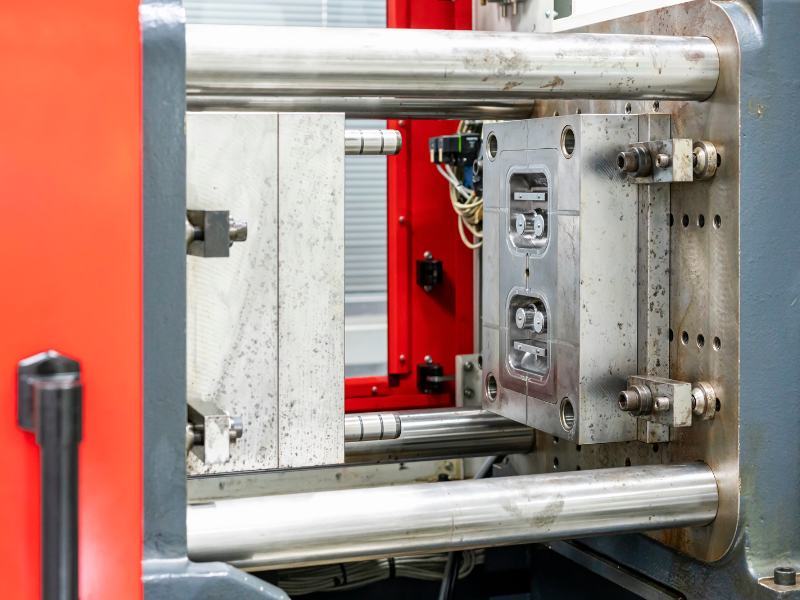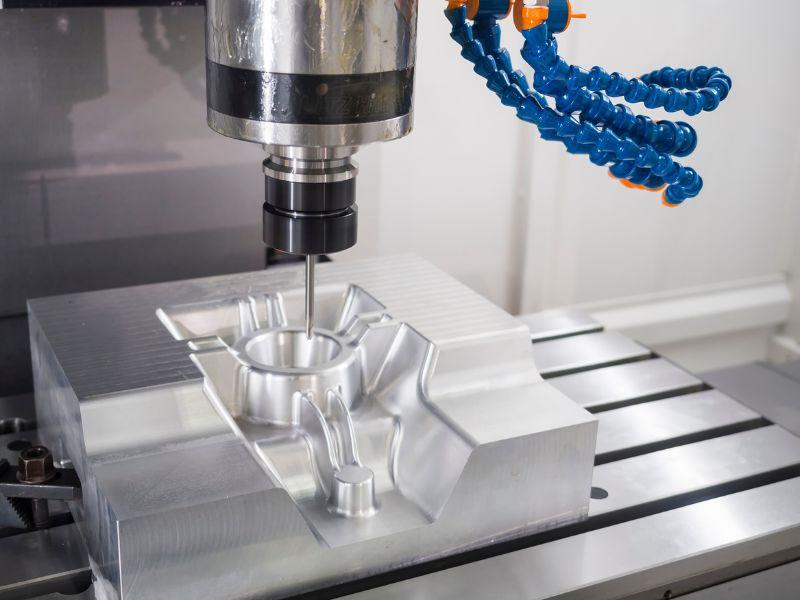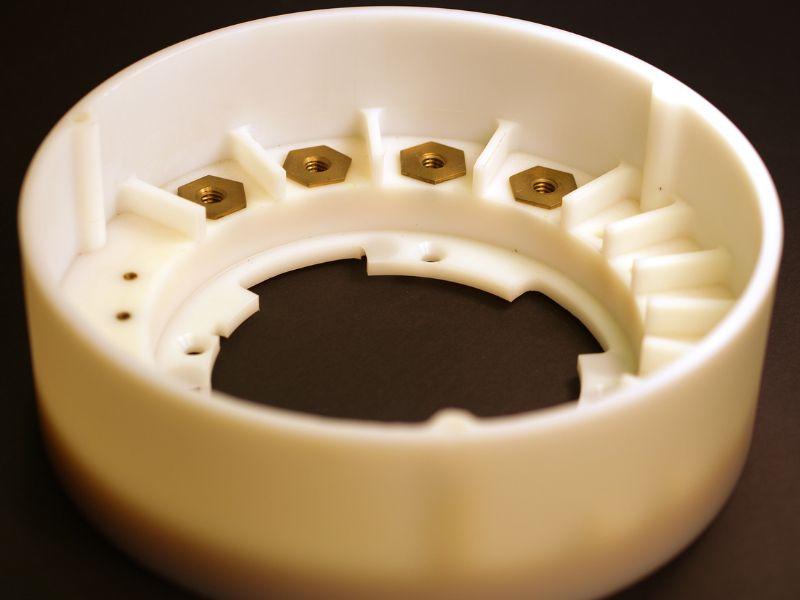Hızlı Enjeksiyon Kalıplama
Hızlı Enjeksiyon Kalıplama Nedir?
Hızlı Enjeksiyon kalıplama, plastik bileşenleri kısa sürede ve uygun bir fiyata üretmek için kullanılan bir plastik üretim sürecidir. Kısa sürede parça üretmeyi amaçlayan geleneksel enjeksiyon kalıplama sürecinden nispeten daha hızlıdır. Bu süreç, düşük ila orta hacimli üretim çalışmaları, kısa süreli çalışmalar, prototip üretimi ve köprü üretimi için idealdir.
Hızlı enjeksiyon kalıplama, kısa sürede ve daha ucuz maliyetle yüksek standart kalitede plastik parçalar üretmeyi mümkün kıldığı için imalat sektöründe bir devrim olmuştur. Bu makale, hızlı enjeksiyon kalıplama sürecinin, ilgili süreçlerin, faydaların, uygulamaların ve gelecekteki gelişmelerin kısa bir tanımını verecektir. Ayrıca hızlı enjeksiyon kalıplama, hızlı prototipleme enjeksiyon kalıplama ve üretim üzerindeki etkileri gibi alanlara da bakacağız.
Hızlı enjeksiyon kalıplama arasında kalıyor hızlı prototipleme Ve prodüksi̇yon enjeksi̇yon kaliplama. Bu teknik prototipleme, köprü kalıplama ve düşük hacimli üretimi destekler. FDM ve SLA gibi katkı yöntemleri form ve uyumu test etmek için iyi çalışır, ancak genellikle bu tür parçalar gerçek parçalarla test etmenin yerini tutmaz. enjeksiyon kalıplı parçalar. Hızlı enjeksiyon kalıbı aynı zamanda ilk tasarımlar tam olarak doğru olmadığında sorunları düzeltmek için yeterince hızlı ve uygun maliyetlidir.
Hızlı enjeksiyon kalıplama, şirketlerin tasarımları test etme süresini artırarak nihai ürünün kalitesini yükseltmiştir. Bazı üreticiler, hızlı enjeksiyon kalıplama ile oldukça fazla test yaptı. hızlı prototip bazlı poliüretan dökümler, ancak döküm malzemelerin malzeme özellikleri enjekte edilen kalıplanmış reçinelerinkinden önemli ölçüde farklı olabileceğinden, birçok kez testler çözümsüz kalmıştır.

Hızlı Enjeksiyon Kalıplama nasıl çalışır?
Hızlı enjeksiyon kalıplama prototipleme, geleneksel enjeksiyon kalıplama sürecine benzer, ancak süreci daha hızlı hale getirmek için bazı varyasyonlara sahiptir.
Tasarım ve Kalıplama: Hızlı enjeksiyon kalıpları, kısa sürede kalıp oluşturmak için Bilgisayarlı Sayısal Kontrol işleme ve Stereolitografi gibi teknolojileri kullanan bir tekniktir. Bu kalıplar genellikle alüminyum veya yumuşak çelikten yapılır çünkü bu malzemelerin işlenmesi normal kalıplarda kullanılan sertleştirilmiş çeliğe göre daha kolaydır.
Enjeksiyon Kalıplama Süreci: Kalıp hazır olduğunda, enjeksiyon kalıplama işlemi başlar. Süreç, kalıp boşluğuna çok yüksek bir basınçla enjekte edilen erimiş plastiğin kullanılmasını içerir. Malzeme istenen sıcaklığa ulaştığında ve katılaştığında kalıp açılır ve nihai parça dışarı atılır.
Çevrim Süresi Azaltımı: Yüksek hızlı CNC makineleri ve optimize edilmiş kalıp tasarımları da döngü sürelerinin kısaltılmasına büyük ölçüde katkıda bulunur. Ayrıca parçaların hızlı bir şekilde katılaşmasına yardımcı olur ve geliştirilmiş soğutma yöntemleri de süreçte rol oynar.
Hızlı Enjeksiyon Kalıplamanın Avantajları
Hızlı enjeksiyon kalıplama, onu birçok sektör için tercih edilen bir seçenek haline getiren çok sayıda avantaj sunar: Hızlı enjeksiyon kalıplama, onu birçok sektörde kullanım için ideal kılan birçok avantaja sahiptir:
- Hız: En büyük avantaj, ürünlerin üretim hattında üretilmesi için geçen süredir. Hızlı enjeksiyon kalıplama ile parça üretimi birkaç gün veya hafta sürebilirken, geleneksel yöntemlerle bu süre aylar sürebilir.
- Maliyet Etkinliği: Daha az takım maliyeti ve daha kısa döngü süresi, özellikle düşük ila orta hacimli üretim için toplam maliyeti daha az hale getirir.
- Esneklik: Hızlı enjeksiyon kalıplama, tasarım geliştirme sürecinde kolayca değiştirilebildiğinden küçük ölçekli üretim ve prototipleme için idealdir.
- Kalite: Bununla birlikte, hızlı enjeksiyon kalıplama çok hızlı bir süreçtir ve pürüzsüz yüzey kaplamalarına ve sıkı toleranslara sahip yüksek kaliteli parçalar üretebilir.
- Malzeme Çeşitliliği: Çok çeşitli termoplastikler kullanılabilir, bu da ürünün gerekli özelliklerine göre malzeme seçimini mümkün kılar.
Hızlı Enjeksiyon Kalıplama Uygulamaları
Hızlı enjeksiyon kalıplama, sayısız faydası nedeniyle çeşitli ürünlerin imalatında yaygın olarak benimsenen bir tekniktir.
Hızlı enjeksiyon kalıplama, çeşitli endüstrilerde kullanılan çok yönlü bir üretim sürecidir ve her endüstrinin ürün geliştirme, test etme ve üretimde hızlı enjeksiyon kalıplama kullanmanın kendi avantajları vardır. Otomotiv endüstrisinde, hızlı enjeksiyon kalıplama uygulaması, seri üretimden önce test ve sertifikasyon için prototiplerin ve sınırlı sayıda parçanın oluşturulmasında esastır. Bu süreç, üreticilerin kısa sürede prototip parçalar üretmesini sağlar ve bu da test ve yeniden tasarımda faydalı olabilir.
Bu şekilde, ürün kullanımdayken ortaya çıkabilecek herhangi bir sorun tespit edilebilir, böylece nihai ürünün kalitesi ve verimliliği artar. Ayrıca, parçaların büyük miktarlarda ve daha hızlı bir şekilde üretilmesini sağlayarak özelleştirmeye yardımcı olur, üreticilerin farklı otomobil modelleri için özel parçalar üretmesine olanak tanır ve böylece ürün farklılaşmasını artırır.
Tüketici elektroniği sektöründe:
Hızlı enjeksiyon kalıplama, sektörün değişkenliği ve rekabet gücü göz önüne alındığında uygundur. Geliştirilen ürünlerin tüketicilerin beklentilerini karşılamasını ve pazardaki mevcut trendlerle uyumlu olmasını sağlamak için akıllı telefonlar, tabletler ve giyilebilir cihazlar gibi aygıtlar için prototiplerin hızlı bir şekilde geliştirilmesine ve yeni tasarımların test edilmesine yardımcı olur. Bu süreç aynı zamanda elektronik parçaların ve muhafazaların uyumluluğunu kontrol ederek gerektiği gibi çalışmalarını sağlamak için kullanılabilecek işlevsel modellerin oluşturulmasına da olanak tanır. Küçük ölçekli üretim veya pazarın test edilmesi için hızlı enjeksiyon kalıplama kısa süreli çalışmalar için idealdir.
Tıbbi cihaz endüstrisi:
Bu endüstri, hızlı enjeksiyon kalıplama ile mümkün olan yüksek doğruluk, standartlara bağlılık ve hızlı ürün geliştirme gerektirir. Bu süreç, tıbbi bileşenlerin ve cihazların kısa sürede büyük miktarlarda üretilmesini mümkün kılar ve cihazlar kısa sürede test edilip modifiye edildiğinden, belirlenen düzenleyici standartları karşılayabilir ve işlevlerini etkili bir şekilde yerine getirebilirler. Belirli bir hastanın ihtiyaçlarına uyacak şekilde tıbbi cihazları hızlı bir şekilde oluşturma ve değiştirme yeteneği, bireyselleştirilmiş bakım sağlayarak özellikle yararlıdır. Buna ek olarak, tıbbi cihaz tasarımlarının üretim öncesi test edilmesi ve doğrulanması, nihai ürünlerin güvenli ve etkili olmasını garanti etmek için önemlidir.
Havacılık ve uzay endüstrisinde:
Hızlı enjeksiyon kalıplama, işlevsellik ve güvenilirlik için çok önemli olan hafif ve yüksek mukavemetli bileşenler oluşturmak için uygulanır. Aynı zamanda farklı iç donanımların, kontrol panellerinin ve havacılık araçlarının yapısal parçalarının maketlerinin oluşturulmasına yardımcı olarak bu endüstrinin yüksek performans ve güvenlik taleplerine dayanabileceklerini garanti eder.
Hızlı enjeksiyon kalıplama, kaliteden ödün vermeden teslim sürelerini kısalttığı ve maliyetleri düşürdüğü için özel veya düşük hacimli havacılık parçalarının üretimi için de etkili bir çözümdür. Ayrıca, çeşitli yüksek performanslı malzemelerden yapılan parçaların hızlı prototiplenmesini ve test edilmesini sağlayarak malzeme tanımlama ve doğrulamaya yardımcı olur.
Endüstriyel ekipman sektörü:
Bu sektör, uygulama ortamındaki zorlu koşullara dayanabilecek dayanıklı ve güvenilir parçaların oluşturulmasını sağlayarak hızlı enjeksiyon kalıplamadan faydalanmaktadır. Bu süreç, makine ve ekipmanlarda kullanılmak üzere karmaşık parçaların ve alt montajların yüksek düzeyde doğruluk ve güvenilirlikle geliştirilmesine yardımcı olur. Yeni endüstriyel ürünlerin hızlı bir şekilde geliştirilmesi ve piyasaya sürülmesi, üreticilerin pazara sunma süresini en aza indirmelerini sağlayan önemli bir rekabet avantajıdır.
Ayrıca, hızlı enjeksiyon kalıplama, gerçek endüstriyel koşullarda test edilebilecek modellerin oluşturulmasına olanak tanır; bu da gerçek üretim sürecinde ortaya çıkabilecek olası sorunların belirlenmesinde yararlıdır.
Hızlı enjeksiyon kalıplama, üretkenliği artıran, masrafları azaltan ve çeşitli alanlarda ürün oluşturma sürecini hızlandıran yenilikçi bir teknolojidir. Otomotiv, tüketici elektroniği, tıbbi cihazlar, havacılık ve endüstriyel ekipman endüstrileri, kullanımından yararlanan alanlardan bazılarıdır ve bu, modern üretim dünyasında ne kadar önemli olduğunu göstermektedir.

Hızlı Enjeksiyon Kalıpları
Hızlı enjeksiyon kalıp takımları, hızlı enjeksiyon kalıplama sürecindeki en önemli faktörlerden biridir. Hızlı parça üretiminin en önemli yönü olan kalıbın yapımını içerir.
Hızlı Enjeksiyon Kalıbı Kalıp Türleri
Hızlı enjeksiyon kalıplama, malzeme özelliklerine ve kalıbın amaçlanan uygulamasına bağlı olarak farklı kalıp türlerinin kullanılmasını içerir.
- Alüminyum Kalıplar: Bunlar, kolayca işlenebilmeleri ve yüksek ısı transfer oranları nedeniyle hızlı enjeksiyon kalıp takımlarının oluşturulması için yaygın olarak seçilir. Alüminyumun ısı iletkenliği iyidir ve bu da soğutma süresinin kısaldığı, dolayısıyla üretim hızının arttığı anlamına gelir. Alüminyum kalıplar, zamanın çok önemli olduğu prototip ve küçük ila orta ölçekli seri üretim için uygundur.
- Yumuşak Çelik Kalıplar: Yumuşak çelik kalıplar alüminyum kalıplardan daha dayanıklıdır ve bu nedenle biraz daha yüksek üretim oranları için kullanılabilir. Alüminyum kalıplar kadar hızlı soğumasalar da, daha sert kalıplara ihtiyaç duyan parçaların yapımında avantajlı olan daha fazla güç ve dayanıklılık sunarlar.
- Hibrit Kalıplar: Hibrit kalıplar, maliyet, dayanıklılık ve üretim hızı açısından her iki dünyanın da en iyisini elde etmek için farklı malzemelerden yapılır. Örneğin, çelik bir çerçeve içindeki alüminyum bir parça, alüminyumdaki yüksek ısı dağılımı oranından ve çeliğin mukavemetinden yararlanabilir. Bu şekilde üreticiler her iki malzemenin de en iyisini elde edebilir, kalıbı üretim gereksinimlerine uyarlayabilir ve uygun maliyetli ancak güçlü bir çözüm elde edebilir.
Bu çeşitli hızlı enjeksiyon kalıp takımları, esneklik ve üretkenlik sunarak üreticilerin üretim ihtiyaçlarına ve hedeflerine bağlı olarak en uygun türü seçmelerine olanak tanır.
Hızlı Enjeksiyon Kalıpları İçin Tasarım Yaparken Dikkate Alınması Gereken Faktörler
İşlevsel testler için prototip tasarlarken göz önünde bulundurulması gereken bazı faktörler şunlardır.
- Malzeme Seçimi: Kalıp için doğru malzemenin seçilmesi çok önemlidir. Yapılması gereken değerlendirmelerden bazıları parçanın karmaşıklığı, üretilecek parça sayısı ve gerekli yüzey kalitesini içerir.
- Alet Tasarımı: Döngü süresini azaltmak ve yüksek kaliteli parçalar üretmek için takımların tasarımı optimize edilmelidir. Dikkate alınması gereken faktörlerden bazıları soğutma kanalı tasarımı, kapının konumu ve çekim açılarıdır.
- Bakım: Kalıpların bakımı ve muayenesi, kalıpların dayanıklılığı ve üretilen parçaların kalitesi açısından kritik öneme sahiptir. Hızlı enjeksiyon kalıpları, kullanılan malzemeler daha yumuşak olduğu için diğer kalıplara göre daha sık bakıma ihtiyaç duyabilir.
Hızlı enjeksiyon kalıplamanın faydaları:
Hızlı enjeksiyon kalıplama ile gelen ve onu dünya çapında birçok üretici için tercih edilen bir seçenek haline getiren çeşitli avantajlar vardır. En önemli avantajlardan biri teslim sürelerindeki azalmadır. Kalıp üretmek için harcanan zaman, Bilgisayarlı Sayısal Kontrol işleme ve Katmanlı üretim gibi modern üretim yöntemlerinin kullanılmasıyla da azaltılır. Bunun üretim süreci üzerinde olumlu bir etkisi vardır, çünkü şirketlerin ürünlerini pazara çok daha hızlı bir şekilde sunmalarını sağlayarak onlara rekabet avantajı sağlar.
Ayrıca, hızlı enjeksiyon kalıp takımları üretmek daha ucuzdur. Daha düşük maliyetli malzemelerin kullanılması ve daha hızlı üretim süresinin etkinliği, önemli maliyet düşüşlerine neden olur. Bu tür tasarruflar, bütçelerini maksimum düzeyde optimize etmeye çalışan KOBİ'ler için özellikle değerli olabilir. Diğer bir fayda ise, hızlı enjeksiyon kalıplama ile tasarım söz konusu olduğunda çok fazla esneklik olmasıdır. Bu süreç, prototip oluşturma aşamasında çok önemli olan hızlı değişiklikler yapılmasına ve yeni tasarımlar ortaya çıkarılmasına olanak tanır.
Tasarımcılar tasarımlarında kolayca değişiklik yapabilir ve nihai ürünü tasarım ve işlevsellik açısından doğru hale getirebilirler. Uzun gecikmeler veya yüksek masraflar olmadan hızlı değişiklikler yapabilme yeteneği, ürün geliştirme sürecinin etkinliğini ve üretkenliğini artırır.
Hızlı Prototipleme Enjeksiyon Kalıplama
Hızlı prototipleme enjeksiyon kalıplama, prototiplerin geliştirilmesinde kullanılan hızlı enjeksiyon kalıplamanın bir alt kategorisidir. Konsepti ve fiziksel tezahürü birbirine bağlayarak hızlı yineleme ve prototiplemeye olanak tanır.
Hızlı Prototipleme Enjeksiyon Kalıplama, bir enjeksiyon kalıplama makinesi kullanılarak nihai ürünün bir prototipini oluşturma sürecidir.
- Tasarım ve CAD Modelleme: Süreç, üretilecek parçanın 3D bilgisayar destekli tasarım (CAD) modelinin oluşturulmasıyla başlar. Bu, asıl ürünün üretileceği kalıbı yapmak için kullanılan ana kopyadır.
- Aletler: Kalıp, CAD modelinden hızlı enjeksiyon kalıplama yöntemleri kullanılarak oluşturulur. Bu adım, üretimde modern teknolojilerin uygulanmasıyla elde edilir.
- Enjeksiyon Kalıplama: Prototip parçaların gerçek üretim parçalarına benzemesini sağlamak için gerçek parçalar enjeksiyon kalıplama yoluyla üretilir.
- Test ve Yineleme: Prototip parçalar operasyonel verimlilikleri, aralarındaki boşluklar ve yüzeyin pürüzsüzlüğü açısından incelenir. Yapılması gereken herhangi bir tasarım değişikliği varsa, bunlar hemen yapılır ve yeni prototipler üretilir.
Enjeksiyon Kalıplama Hızlı Prototiplemenin Avantajları
- Hız: Hızlı prototipleme enjeksiyon kalıplama, prototiplerin geliştirilmesi ve test edilmesi için geçen süreyi büyük ölçüde azaltarak bir ürünün geliştirilmesi için geçen süreyi kısaltır.
- Maliyet Etkinliği: Ayrıca takım maliyetleri açısından daha ucuzdur ve daha kısa döngü sürelerine sahiptir, bu da onu prototipleme için uygun hale getirir.
- Tasarım Doğrulama: Prototipleme, gelecekte büyük miktarlarda üretilecek bir ürünün ön modelinin geliştirilmesidir; bu, nihai ürünün hatasız olmasını ve ürünle ilgili olabilecek sorunların erken bir aşamada tespit edilmesini sağlamak için yapılır.
- Malzeme Testi: Nihai ürün için en uygun olanı belirlemek amacıyla çeşitli malzemelerin test edilmesine olanak tanır.

Hızlı Prototipleme Enjeksiyon Kalıplama Uygulamaları
- Ürün Geliştirme: Yeni ürünlerin tasarlanması ve değerlendirilmesi için ürün geliştirmenin ilk aşamalarında yaygın olarak uygulanır.
- İşlevsel Test: Ürünün gerçek koşullardaki performansını değerlendirmek için kullanılabilecek somut modeller oluşturur.
- Pazar Testi: Şirketlerin büyük ölçekli üretime geçmeden önce piyasada test etmek için küçük miktarlarda ürün üretmesini sağlar.
Hızlı Enjeksiyon Kalıplamada Teknolojik Gelişmeler
Hızlı enjeksiyon kalıplama alanı da teknoloji ve işlevselliği açısından çok fazla gelişme yaşamıştır.
- Katmanlı Üretim Entegrasyonu
3D baskı olarak da bilinen katmanlı üretim, hızlı enjeksiyon kalıplama ile birleştirildiğinde kalıplama sürecini büyük ölçüde dönüştürmüştür. 3D baskı, kısa sürede ve düşük maliyetle karmaşık kalıp şekilleri oluşturabilir, bu da teslim süresini en aza indirmeye ve daha fazla yinelemeye olanak sağlamaya yardımcı olur.
- Gelişmiş Malzeme Seçenekleri
Kalıpların ve parçaların yapımında kullanılan malzemelerdeki ilerleme, hızlı enjeksiyon kalıplamanın kullanımında yeni fırsatlar yaratmıştır. Plastikler ve kompozitler için üstün malzemeler daha iyi mekanik özellikler sunarken, üstün kalıp malzemeleri daha iyi aşınma direnci ve soğutma yetenekleri sunmaktadır.
- Simülasyon ve Analiz Yazılımı
Bilgisayar destekli tasarım ve analiz araçları, doğru kalıp tasarımına ve sürecin kontrolüne yardımcı olur. Bu araçlar, iyi parçalar üretmek için gerekli değişikliklerin yapılmasını sağlayan çarpılma, büzülme ve soğuma hızı tahminlerini içerir.
- Otomasyon ve Robotik
Otomasyon ve robotik kullanımı, hızlı enjeksiyon kalıplama sürecini geliştirerek daha hızlı ve doğru hale getirmiştir. Otomatik sistemler tarafından gerçekleştirilen işlevlerden bazıları, döngü süresini ve insan hatalarını en aza indirmeye yardımcı olan malzeme taşıma, kalıp değiştirme ve parça denetimini içerir.
- Dijital Üretim
Dijital üretimdeki ilerleme tasarım, üretim ve kalite güvencesi arasında bağlantı kurmayı kolaylaştırmıştır. Dijital platformların kullanımı, verilerin gerçek zamanlı olarak izlenmesine ve analiz edilmesine yardımcı olmakta, böylece üretim süreci boyunca ürünlerin kalitesini ve izlenebilirliğini korumaktadır.
Çözüm
Hızlı plastik enjeksiyon kalıplama imalat endüstrisinde benimsenen en devrimci teknolojilerden biridir. Bu, yüksek kaliteli plastik parçaları büyük miktarlarda ve kısa bir süre içinde üretme kabiliyeti nedeniyle onu çeşitli endüstriler için çok kullanışlı bir araç haline getirmektedir. Hızlı enjeksiyon kalıp takımından hızlı prototipleme enjeksiyon kalıplamaya kadar, bu alandaki yenilikler hala artmakta ve üretimde elde edilebileceklerin sınırlarını genişletmektedir.
Şirketlerin bu teknolojiden tam olarak yararlanabilmesi için hızlı enjeksiyon kalıplamanın süreçlerini, faydalarını ve uygulamalarını anlamak önemlidir. Hızlı enjeksiyon kalıplama, günümüzde ve geçmişte olduğu gibi gelecekte de teknolojik ilerlemenin önemli bir sağlayıcısı olmaya devam edecektir.

